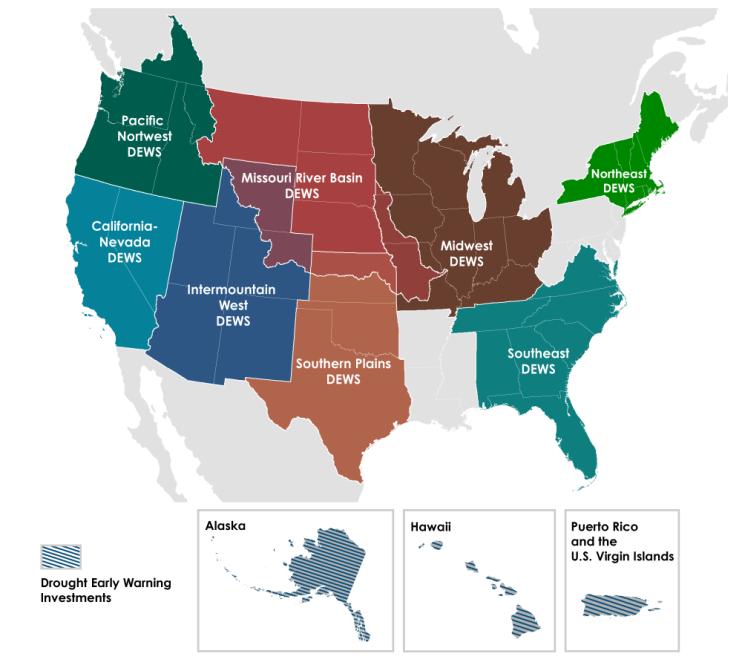Drought Early Warning
Drought early warning systems (DEWS) use networks of federal, tribal, state, local, academic, and other partners to make climate and drought science accessible and useful for decision makers. These systems improve stakeholders’ capacity to monitor, forecast, plan for, and cope with the impacts of drought.
Why Drought Early Warning?
Drought is a recurring natural phenomenon that is often called “the creeping disaster.” Unlike other natural hazards, such as hurricanes, floods, and tornadoes, droughts develop gradually over a long period of time. The gradual nature of drought can prevent us from recognizing drought’s true impacts, often diminishing the urgency that would otherwise trigger a timely and comprehensive response.
Recognizing drought risks in a timely manner is dependent on our ability to monitor and forecast the diverse physical indicators of climatological drought, as well as relevant economic, social, and environmental impacts. A DEWS provides accurate, timely, and integrated information on drought conditions at the relevant spatial scale. This can help governments and communities make proactive decisions to minimize the economic, social, and ecosystem losses associated with drought.

DEWS: A Regional Approach
A Drought Early Warning System, or DEWS, is a network of regional and national partners that share information and coordinate actions to help communities in the region cope with drought. Developing and implementing regional DEWS allows for responsiveness to particular geographic and hydrologic circumstances, as well as value-added information needs specific to stakeholders in the respective areas.
Through developing regional DEWS, the National Integrated Drought Information System (NIDIS) is building the foundation for a nationwide DEWS to improve drought monitoring, forecasting, planning, and preparedness capabilities across the nation.
Drought Early Warning Components
A regional DEWS is not simply the dissemination of a forecast. It is an integrated information system that comprises multiple information sets, such as forecasting, monitoring, research, capacity-building, and public outreach. A DEWS encourages innovation by integrating new, locally relevant drought information, and supports the introduction of new technologies that detect and communicate drought risks and warnings.
Each of the regional DEWS integrates five key components of a drought early warning system—observation and monitoring, prediction and forecasting, planning and preparedness, communication and outreach, and interdisciplinary research and applications—and implements them according to regional needs and assets.
Promoting the growth of observational networks and drought indices by increasing the data resources available for drought monitoring and filling spatial and temporal gaps in data coverage.
Assessing current operational drought forecast system capabilities and developing a strategy to improve official monthly, subseasonal, and seasonal drought outlooks.
Improving the dissemination of drought research, tools, and planning information in formats that are timely, accessible, and useful for drought management and decision making.
Providing drought information and tools to increase individual and community capacity for minimizing the social, economic, and environmental impacts of drought.
Ensuring federal research is coordinated and integrated into decision making, leading to better informed and more timely decisions by vulnerable stakeholders and government leaders.
Observation & Monitoring
NIDIS advances capabilities in monitoring and observing relevant drought impacts in hydrology, agriculture, and other related fields at a variety of spatial and temporal scales. Efforts focus not just on filling gaps in data, but assuring the compatibility of new data resources and promoting the use of the most appropriate monitoring products and data sources for specific spatial scales and applications.
Prediction & Forecasting
The reliability and usefulness of official drought forecasts and outlooks (and the prediction tools and models that inform them) is vital to any DEWS. These efforts focus on improving the current monthly, subseasonal, and seasonal drought outlooks with consideration for extending the forecast service to longer lead times. These activities leverage advancements in drought research and expand current work to include operational drought prediction systems where possible.
Planning & Preparedness
By nature, monitoring, planning for, and reducing drought risk must be a collaborative process. These efforts focus on increasing drought resilience through engagement, networking, and collaboration. This involves coordinating with the regional DEWS and their respective networks, as well as building on existing partnerships, to improve the dissemination of drought research, tools, and planning information in formats that are timely, accessible, and useful for drought management and decision making.
Communication & Outreach
Outreach and public awareness are essential for effective drought early warning, planning, and preparedness. Through these efforts, NIDIS provides information on current drought conditions, forecasts, impacts, and risks, and points to tools that increase individual and community capacity for minimizing the impacts of drought. This includes sharing stories, lessons learned, and educational resources through various communication mediums.
Interdisciplinary Research & Applications
These efforts help ensure that federal research is as coordinated and integrated into decision making as practicable, promoting interaction between the research community and the beneficiaries of their research. Maintaining a strong connection between sponsored research and the U.S. Drought Portal helps cultivate these interactions and gives stakeholders and leaders the tools to make better and more timely decisions.

